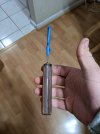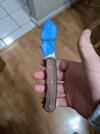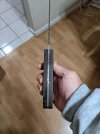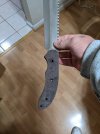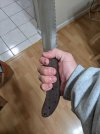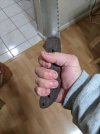I started making some fixed blades (no pivot) and am having difficulties figuring out the handles. The first one feels nice in the hand but the handle is very thick and blocky. It's ugly looking. It feels good to me, though.
The other, a Camillus Hide machete (sorry, I had to make at least one Rambo knife, just for the experience of it!) feels perfect with just one scale on it. I think the scales are 1/4" thick (just guessing, I did not measure it). Of course, it is not symmetrical with just one scale. I think it will be pretty thick with the second scale attached.
So, how do determine how thick the handles should be?
And how do you determine certain details like whether the top of the scale should taper into the blade or stick out perpendicularly like a shelf? I am finding that the thick handled, short bladed knife feels pretty good when I can rest my thumb on the top of that beefy scale but almost all the knives I see have the top of the scale taper in.
Thanks for your thoughts, folks!
The other, a Camillus Hide machete (sorry, I had to make at least one Rambo knife, just for the experience of it!) feels perfect with just one scale on it. I think the scales are 1/4" thick (just guessing, I did not measure it). Of course, it is not symmetrical with just one scale. I think it will be pretty thick with the second scale attached.
So, how do determine how thick the handles should be?
And how do you determine certain details like whether the top of the scale should taper into the blade or stick out perpendicularly like a shelf? I am finding that the thick handled, short bladed knife feels pretty good when I can rest my thumb on the top of that beefy scale but almost all the knives I see have the top of the scale taper in.
Thanks for your thoughts, folks!

